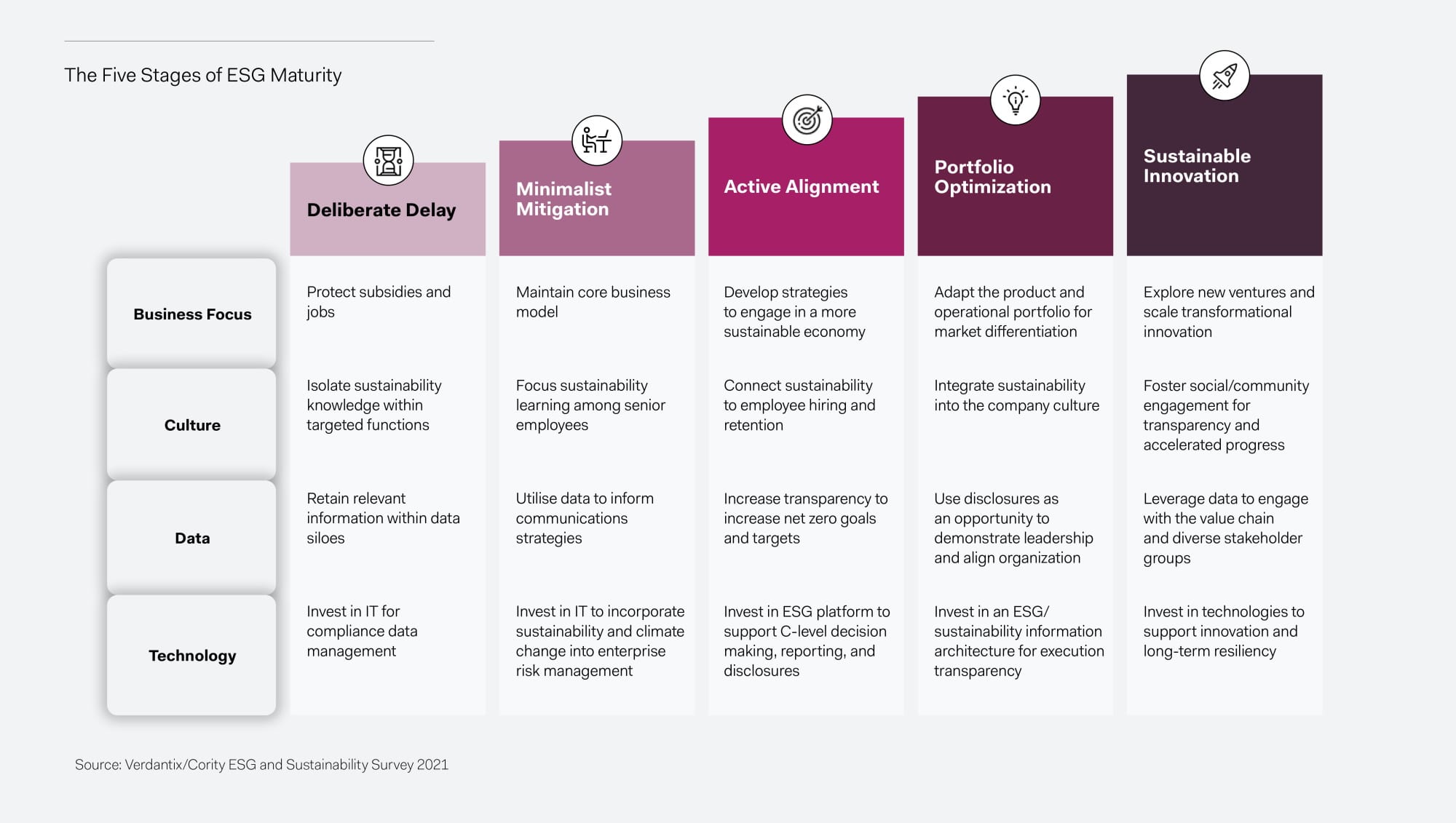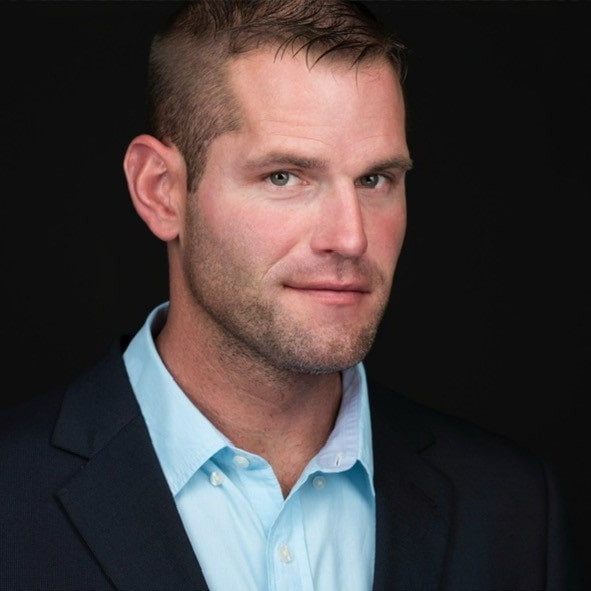Maturity Pathway for ESG & Sustainability
Sponsored by: Cority
According to a global study from the independent research firm, Verdantix, it was revealed that 92% of companies are adapting their business strategy and model to be more sustainable and plan to increase investment in sustainability initiatives to improve ESG performance for 2022 and beyond. With growing awareness of the threats posed by climate change, and increased demand for sustainability reporting from regulators and investors, many organizations are struggling to determine where to start or where they might fit in that process.
“Delaying engagement with ESG and sustainability is no longer a tenable strategy,” said Kim Knickle, Research Director, ESG & Sustainability at Verdantix. “The market and stakeholder pressure are too strong to ignore, and the benefits of active sustainable business strategies are increasingly apparent. The data reveals that forward-thinking firms are aiming to improve ESG performance by investing in EHS and ESG platforms in 2022 and beyond.”
This article will examine the ESG Maturity Pathway, which separates organizations into five levels based on their overall ESG program maturity. These levels are based on four common themes - Business Focus, Culture, Data, and Technology. We will look at how they are used to improve ESG performance and can be leveraged as a competitive differentiator.

Deliberate Delay
Organizations in this phase have the least mature sustainability strategies that often take a defensive approach and focus primarily on protecting subsidies and jobs and maintaining core business models. Far too often, organizations in this phase tend to lobby against sustainability initiatives, isolating sustainability within targeted functions. This is a common phase for many organizations, and for the decision-makers involved, the ability to influence and move the needle towards ESG and Sustainability can be challenging. Businesses that fail to adapt and adjust risk potential reputation and investor backlash, not to mention the possibility of losing capital and commercial opportunities with sustainability-conscious organizations.Minimalist Mitigation
In this phase, organizations are “interested” in ESG and sustainability, but that interest is usually limited to senior leaders or executives. This is where those in leadership start recognizing trends and identifying potential legislation or regulations related to ESG & Sustainability. Organizations in this phase focus on maintaining the core business model and often utilize data to direct communication strategies. Any efforts or investments in this phase often occur when businesses invest in IT solutions as an initial effort in tackling sustainability and climate change data collection/reporting. Usually, organizations in this phase recognize the need for and importance of sustainability but often lack the resources and knowledge to effectively improve ESG performance.Active Alignment
This phase is where organizations start to make a change and take a proactive approach toward ESG & Sustainability. There is a considerable shift in the organizational thought process, with significant movement towards aligning business strategies with sustainability concepts. Businesses in this phase often find ways to connect sustainability to labor relations in areas like employee hiring and retention. Improved messaging through transparency start to influence and assist in achieving critical ESG deliverables like net zero goals and targets. Those in this phase often need additional solutions, such as an ESG platform, which will support C-Level decision-making while streamlining the reporting and disclosure process.Portfolio Optimization
It is in the Portfolio Optimization stage where organizations further expand and develop strategies to engage in a more sustainable economy. Businesses in this phase often ask, “How can we shift parts of our operation to influence and drive change”? Business focus shifts to adapting the product and operational portfolio for market differentiation. The organizational culture continues to change and develop as sustainability gets further integrated. Building on the previous phase, continued transparency will occur as businesses utilize disclosure as an opportunity to demonstrate leadership while being aligned from an organizational perspective. To best execute strategies, organizations in this phase will continue to invest heavily in technological solutions for ESG & Sustainability.Sustainable Innovation
At the top of the ESG Maturity curve is Sustainable Innovation. The most mature corporate sustainability strategies, or those that view sustainability as a critical market differentiator, focus on sustainable development across the value chain. Strategy in this phase often focuses on sustainable innovation as a core tenet of company strategy. Business focus is concentrated on scaling innovation, with an emphasis placed on identifying new ventures. Organizations in this stage often are critical in social and community engagement, often furthered by unfettered transparency that drives overall progress (change). A continued emphasis on engaging the value chain occurs in this phase, as organizations leverage data to improve and drive change. Often, this allows businesses to expand their footprint into a wide range of diverse stakeholder groups. From a technology perspective, firms in this phase will continue to invest in technological solutions that will support innovation and long-term organizational resiliency.Where does your organization fit in?
Given the five stages of the ESG Maturity Curve, chances are you recognized indicators that might help you and your organization identify how to get the process moving. For many, transitioning out of the least mature stages can be challenging, as building support and organizational buy-in is often a daunting task.In some cases, organizational approach and acceptance towards sustainability may be positively influenced by consumer sediment or potential regulatory requirements. But as optionality reduces, organizations must develop strategies and identify solutions to take advantage of sustainable performance.
As your organization grows within the Maturity process, ESG and sustainability strategies will continue to shift. They will be impacted by factors like corporate business priorities, current levels of technological adoption, and levels of data visibility into operations.
Solutions for ESG & Sustainability Program Management
According to a 2021 Verdantix study**, it was identified that EHS Functions (Staff, Software, Resources) were the most significant business function in implementing sustainability strategies. This reflects the traditional role and responsibility EHS has for driving performance across key contributors to ESG, including environment, health, and safety performance.Specialized Environmental Health & Safety (EHS), ESG, and sustainability software allow a business to measure related ESG inputs and outcomes across the enterprise, identify areas for improvement, and prioritize projects with robust analytics that enable a data-driven approach. The type of software to support ESG programs should meet the following requirements: designed for ease of use, reporting against standards, access to historical data, visualization tools, and a way to set and measure against company goals. Moreover, the best ESG software ensures that gathered metrics align with real-time shifts from ESG guidelines and sustainability reporting standards. Great ESG software helps organizations meet the challenges of ESG reporting with relative ease while enabling management teams to focus on driving product innovation and improved revenues in the process.
According to a Verdantix survey conducted in 2021, the majority of participants indicated that ESG data is too dispersed and complex to aggregate. *
When evaluating ESG software, decision-makers should consider the following areas:
- Ease of use – A specialized ESG software solution, such as Cority’s, is a unified platform that can break down data silos amongst the entire organization, enabling collaborative data collection across departments, business units, and portfolios to solve administrative and logistical challenges.
- Reporting made simple – Built-in dashboards and visualization tools help users analyze and visualize progress in a simple and meaningful way.
- Metrics to help guide operations – Data that provides a 360-degree view of sustainability and ESG program insights are invaluable to organizations looking to gain actionable insights to drive further improvements and innovations across their organization.
Why Your Business Should Consider Cority for ESG Management Needs
Cority aims to make ESG management and reporting initiatives a more straightforward task. From deployment to training to ongoing support, Cority has all the resources a business needs to ensure the successful implementation and use of new investment in an ESG software solution. Contact Cority today to have a conversation and to schedule a demo to see just how powerful ESG management software is and how it can benefit an operative need. Driving ESG reporting and analysis goals straight to success.* Source: Verdantix Global ESG and Sustainability Governance, Budgets and Priorities Survey 2021
**: Verdantix Global Corporate Survey: ESG And Sustainability Governance, Strategies And Priorities 2021
About the Author

Chris Michie
Cority
Chris Michie is a Product Marketing Manager with Cority and specializes in Environmental and Sustainability solutions. Chris has over 14 years of Environmental and Sustainability experience and holds bachelor’s degrees in Marketing and Graphic Design
from the University of Maryland. Before his role at Cority, Chris managed a Sustainability program for a large agricultural company and worked in Public and Environmental Health with the U.S. Environmental Protection Agency and the U.S. Army, respectively.

